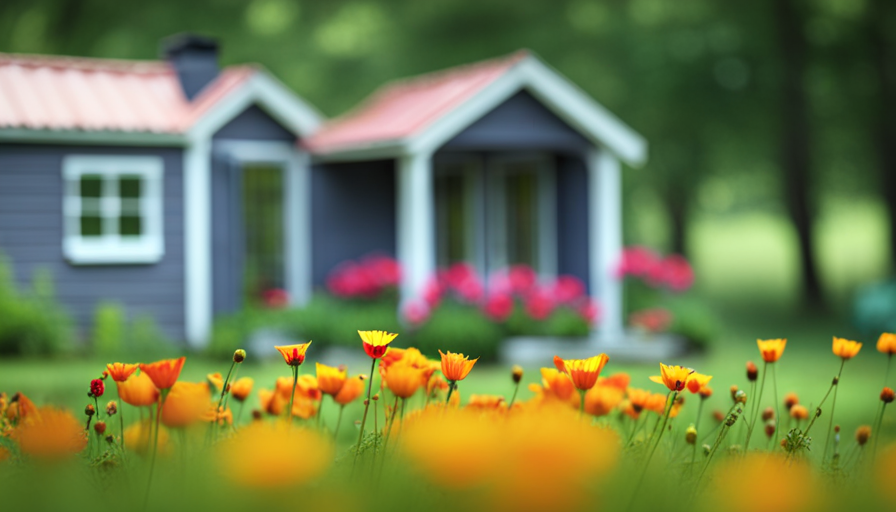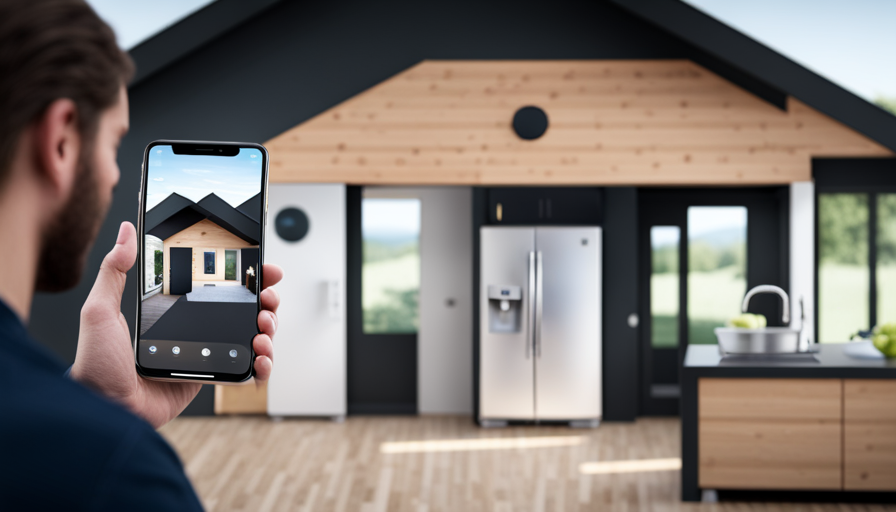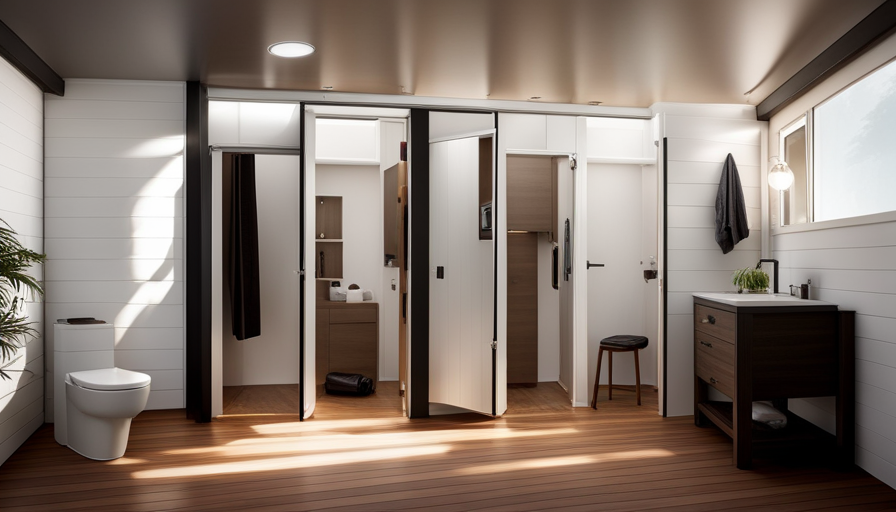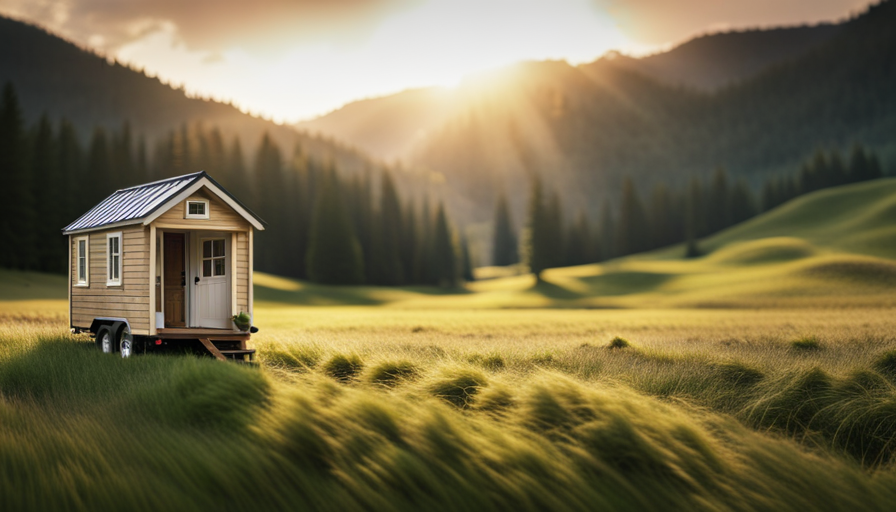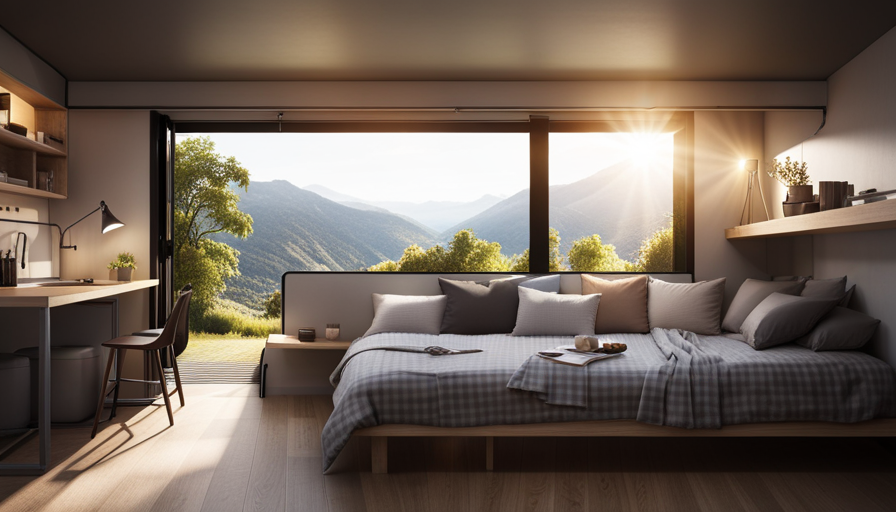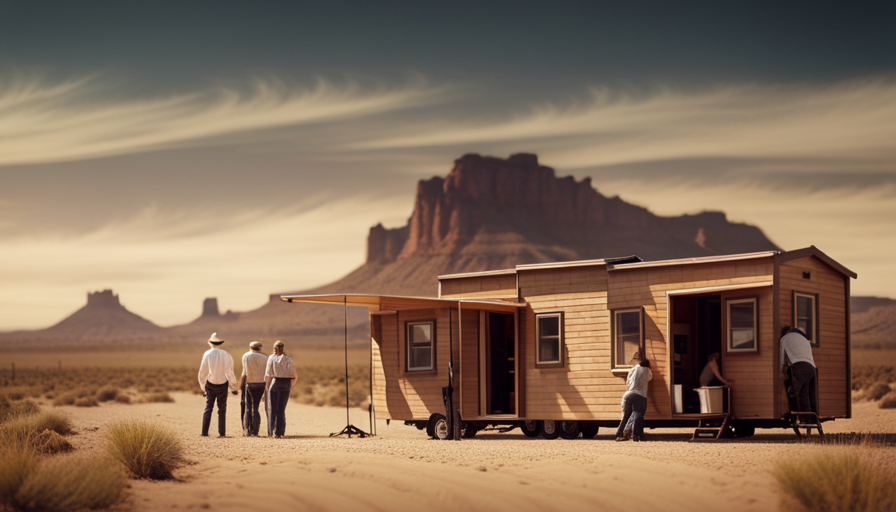How large can a tiny house grow before needing a permit?
This is a question that many aspiring tiny house owners find themselves asking. As someone who has gone through the process of building and living in a tiny house, I understand the importance of navigating through local regulations and building codes.
In order to avoid the hassle of obtaining a permit, there are several factors to consider. First and foremost, it is crucial to familiarize yourself with the zoning regulations in your area. Additionally, understanding the building codes is essential to ensure your tiny house meets safety requirements.
The foundation type, utility connections, and the purpose of your tiny house are all aspects that will impact whether or not a permit is necessary. Lastly, staying up to date with local laws is crucial as regulations may change over time.
By following these guidelines, you can confidently build a tiny house that meets the size requirements to avoid the need for a permit.
Key Takeaways
- Factors such as foundation type, utility connections, and purpose of the tiny house impact the need for a permit.
- Familiarize yourself with local zoning regulations to determine if a permit is needed.
- Understanding building codes is crucial for meeting safety requirements.
- Stay up to date with local laws as regulations regarding tiny houses may change over time.
Understand Local Zoning Regulations
Don’t let pesky permits get in the way of your dream tiny house – find out exactly what your local zoning regulations allow!
Understanding local zoning restrictions and building permit requirements is crucial when determining how big your tiny house can be without needing a permit. Each town or city has its own set of rules and regulations regarding the size and placement of structures, so it’s important to research and comply with these guidelines.
Local zoning regulations typically dictate the maximum square footage, height, setbacks, and even the type of foundation allowed for tiny houses. By familiarizing yourself with these regulations, you can ensure that your tiny house meets all the necessary requirements.
Now, let’s move on to the next section and discuss how to familiarize yourself with building codes.
Familiarize Yourself with Building Codes
When it comes to building a tiny house, it’s important to familiarize yourself with the building codes.
One key point to consider is the minimum size requirements set by the local building department. These requirements may vary depending on the location, so it’s crucial to research and understand the specific regulations in your area.
Additionally, it’s essential to consider safety and health regulations to ensure that your tiny house meets the necessary standards for occupancy and living conditions.
Learn About Minimum Size Requirements
To avoid obtaining a permit, you can build a tiny house that meets the minimum size requirements set by your local zoning regulations. These requirements vary from one jurisdiction to another, so it’s crucial to familiarize yourself with the specific rules in your area. Here are four key points to consider when it comes to minimum size requirements:
-
Research: Begin by researching the minimum square footage required for a dwelling in your locality. This information can typically be found in your local building codes or zoning ordinances.
-
Consult: If you’re unsure about the requirements or need clarification, don’t hesitate to reach out to your local building department or zoning office for assistance.
-
Flexibility: Some areas may have flexibility in their minimum size requirements, allowing for alternative options such as utilizing loft spaces or multi-functional furniture to maximize the use of limited square footage.
-
Exceptions: Certain jurisdictions may have exceptions or exemptions for tiny houses on wheels or accessory dwelling units (ADUs), so be sure to explore these possibilities.
Considering safety and health regulations is crucial when building a tiny house, as they ensure the well-being of its occupants and comply with legal requirements.
Consider Safety and Health Regulations
Adhering to safety and health regulations is crucial in ensuring the well-being of occupants and maintaining legal compliance in the construction of a compact dwelling. When designing a tiny house, it is important to consider safety precautions and health regulations to create a safe and healthy living environment.
To ensure safety, it is necessary to take measures such as installing smoke detectors, fire extinguishers, and carbon monoxide detectors. Additionally, proper ventilation and insulation are essential to prevent mold growth and maintain good air quality.
In terms of health regulations, it is important to follow guidelines for waste management, including proper disposal of sewage and waste water. Furthermore, ensuring access to clean water and a reliable electrical system is crucial for the well-being of the occupants.
By adhering to these safety precautions and health regulations, you can create a safe and healthy living space within the confines of a tiny house. Consider the foundation type for your compact dwelling to ensure stability and structural integrity.
Consider the Foundation Type
First and foremost, let’s explore the different foundation types for a tiny house and how they can affect the need for a permit. When considering foundation options for your tiny house, it’s essential to keep in mind the building restrictions imposed by local authorities.
Here are three common foundation types and their implications:
-
Permanent foundation: Constructing your tiny house on a permanent foundation, such as a concrete slab or crawl space, may exempt you from certain permit requirements. However, it’s crucial to ensure compliance with local building codes.
-
Pier foundation: Utilizing pier foundations, consisting of concrete piers or steel posts, can offer flexibility and portability. Depending on your location, this type of foundation may allow you to avoid obtaining a permit for your tiny house.
-
Skid foundation: Using skids, which are large beams or timbers, to support your tiny house allows for mobility. This type of foundation typically does not require a permit, as the structure is not permanently fixed to the ground.
Considering the foundation type is just one aspect of determining whether a permit is required. To ensure compliance with all regulations, it’s essential to consult with a professional in your local jurisdiction.
Consult with a Professional
It’s crucial to seek guidance from a local professional to ensure compliance with all regulations when determining whether a permit is necessary for your tiny house project. Consulting with a professional offers numerous benefits, such as receiving expert advice on local zoning laws and building codes. They can help you navigate the complex permit process and ensure your tiny house meets all necessary requirements. By consulting with a professional, you can avoid costly mistakes and potential legal issues down the line. They can provide valuable insights on foundation types, materials, and construction techniques that will help you stay within the permitted size limits. Additionally, they can assist in obtaining any required permits or variances. By seeking professional guidance, you can move forward with your tiny house project confidently and with peace of mind. As you consider utility connections, it’s important to be aware of the necessary steps.
Be Aware of Utility Connections
When planning your project, consider how utility connections will fit into the overall design and layout of your tiny home. This is an important aspect to consider because utility connections are essential for a comfortable and functional living space. Here are some key points to keep in mind when dealing with utility connections in your tiny house:
-
Research local zoning regulations: Before proceeding with any utility connections, it’s crucial to understand the specific regulations in your area. Different locations may have different requirements and restrictions regarding utility connections in tiny houses.
-
Plan for water and sewage connections: Ensure that you have access to a reliable water source and a proper sewage system. Depending on your location, you may need to connect to a public water supply or consider alternative options such as rainwater harvesting or well systems.
-
Determine electrical needs: Assess your electrical requirements and plan for the necessary connections. This may involve working with an electrician to ensure your tiny house is wired safely and efficiently.
Considering the purpose of your tiny house, it’s essential to carefully plan and incorporate utility connections that meet your specific needs.
Transitioning into the subsequent section, it’s crucial to also consider the purpose of your tiny house in order to make informed decisions throughout the planning process.
Consider the Purpose of Your Tiny House
When considering the purpose of a tiny house, it’s important to determine if it’ll be used as a permanent residence. This will help guide decisions regarding size, amenities, and legal requirements.
Additionally, exploring the regulations for tiny houses on wheels is crucial. It’ll provide insight into zoning restrictions, building codes, and transportation regulations that may impact the design and construction of the tiny house.
Determine if it Will be Used as a Permanent Residence
If you’re planning on using the tiny house as your permanent residence, you’ll need to consider the size requirements for obtaining a permit. When it comes to permanent residence requirements, there are legal implications you need to be aware of.
To help you understand the importance of complying with these regulations, here are some key points to consider:
- Safety: Meeting size requirements ensures that your tiny house is safe for long-term living.
- Comfort: A larger tiny house will provide more space and amenities for a comfortable lifestyle.
- Functionality: A bigger tiny house allows for better utilization of space and the inclusion of essential features.
- Resale value: A properly permitted tiny house typically holds better resale value in the real estate market.
- Peace of mind: Complying with size requirements and obtaining a permit ensures you are legally protected in your choice of residence.
Now, let’s explore the regulations for tiny houses on wheels.
Explore the Regulations for Tiny Houses on Wheels
Discover the rules and guidelines for mobile tiny homes and learn how you can legally embrace a flexible and adventurous lifestyle on wheels. When it comes to tiny houses on wheels, there are specific regulations that vary by location. First, explore parking options for your tiny house, as finding a suitable place to park is crucial. Some options include RV parks, tiny house communities, or private land with the owner’s permission. Additionally, consider financing options for your mobile tiny home. Traditional mortgages may not be available, but alternatives like personal loans or RV loans could be viable. To provide a clearer picture, here is a table summarizing parking and financing options for mobile tiny houses:
| Parking Options | Financing Options |
|---|---|
| RV parks | Personal loans |
| Tiny house communities | RV loans |
| Private land with permission |
To stay up to date with local laws, continue reading the subsequent section.
Stay Up to Date with Local Laws
To ensure you stay on the right side of the law, make sure you keep up with the latest local regulations regarding tiny house sizes, as ignorance isn’t an excuse. Staying informed about the legal requirements is crucial when it comes to building and living in a tiny house.
Here are four reasons why it’s important to stay up to date with local laws:
-
Compliance: Knowing the specific size limits set by your local jurisdiction will help you build a tiny house that meets all legal requirements.
-
Safety: Local regulations often include guidelines for fire safety, electrical systems, and plumbing. Following these regulations ensures your tiny house is safe for occupancy.
-
Zoning restrictions: Local laws may dictate where you can park or place your tiny house. Being aware of these restrictions will prevent any legal issues in the future.
-
Permits: Some areas require permits for building or living in a tiny house. Staying informed about permit requirements will save you from potential fines or legal consequences.
By staying informed and following the local laws, you can enjoy the benefits of living in a tiny house without any legal complications.
Frequently Asked Questions
How can I determine the size of a tiny house that does not require a permit based on local zoning regulations?
To determine the size of a tiny house that doesn’t require a permit based on local zoning regulations, I’d recommend researching the specific regulations set by your local government. These regulations usually outline the maximum square footage allowed for structures without a permit.
Additionally, you can consult with a local zoning official or building department to get accurate information. Understanding the local regulations is crucial to ensure compliance and avoid any potential legal issues.
What are the specific building codes that I need to be aware of when constructing a tiny house without a permit?
When constructing a tiny house without a permit, it’s crucial to be aware of the specific building codes and local zoning regulations. These regulations vary from one jurisdiction to another, so it’s essential to research the codes applicable to your area. Familiarize yourself with requirements for structural integrity, electrical systems, plumbing, and fire safety. Failure to comply with these regulations can result in fines or even the demolition of your tiny house.
Which type of foundation is most commonly used for tiny houses that do not require a permit?
The most commonly used foundation for tiny houses that do not require a permit includes options such as concrete blocks, gravel pads, and skids. These types of foundations provide stability and support for the structure.
When it comes to building materials for tiny houses, lightweight and durable options like timber, steel, and composite materials are often used. It’s important to ensure that the chosen materials meet the required safety standards for construction.
When consulting with a professional, what specific aspects of my tiny house should I discuss to ensure compliance with regulations?
When consulting with a professional about my tiny house, it’s crucial to discuss specific aspects to ensure compliance with regulations.
During the consulting process, I’ll focus on permit requirements. This includes addressing factors such as size, foundation type, and utility connections.
By assessing these elements, I can determine the maximum size my tiny house can be without requiring a permit.
Consulting professionals will provide technical guidance to ensure my tiny house meets all necessary regulations.
Are there any specific utility connections that I need to be aware of when building a tiny house without a permit?
When building a tiny house without a permit, it’s crucial to be aware of specific utility connections. These include water, electricity, and sewage connections. Without a permit, it’s important to ensure that these connections are properly installed and meet the necessary safety standards. It’s advisable to consult with a professional to ensure compliance with regulations and to obtain guidance on the specific requirements for utility connections when building without a permit.
Conclusion
In conclusion, navigating the world of permits and regulations can be challenging when it comes to building a tiny house. However, by understanding local zoning regulations, familiarizing yourself with building codes, and consulting with professionals, you can avoid the hassle of obtaining a permit.
It’s interesting to note that according to a survey conducted by the American Tiny House Association, approximately 55% of tiny house owners reported facing challenges related to zoning and permitting. This statistic highlights the importance of staying informed and up to date with local laws to ensure a smooth and hassle-free tiny house journey.
Hi, I’m Emma. I’m the Editor in Chief of Tiny House 43, a blog all about tiny houses. While tree houses are often associated with childhood, they can be the perfect adult retreat. They offer a cozy space to relax and unwind, surrounded by nature. And since they’re typically built on stilts or raised platforms, they offer stunning views that traditional homes simply can’t match. If you’re looking for a unique and romantic getaway, a tree house tiny house might just be the perfect option.
